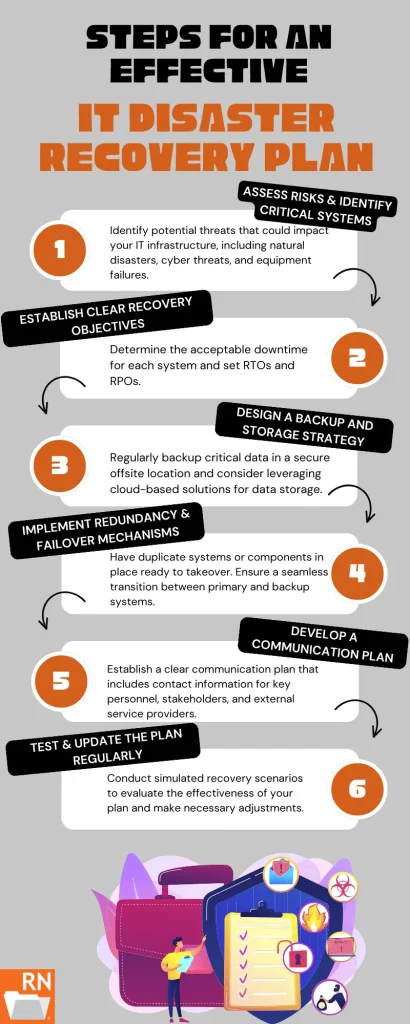
Businesses of all sizes create and manage extensive amounts of electronic data. Unexpected events, ranging from natural disasters to cyberattacks, can cripple operations and jeopardize sensitive data. To safeguard your business against such threats, it is crucial to develop a well-thought-out IT disaster recovery plan. In this blog, we will guide you through the key steps to create an effective plan that ensures business continuity in the face of adversity.
What is an IT Disaster Recovery Plan?
An IT disaster recovery plan (IT DRP) is a comprehensive and structured document that outlines the strategies and procedures an organization will follow to recover and restore its IT systems, data, and technology infrastructure in the event of a disruptive incident or disaster. The primary purpose of an IT disaster recovery plan is to ensure the continuity of critical IT functions and minimize the impact of disruptions caused by various factors, such as natural disasters, cyberattacks, hardware failures, or human errors.
Steps for an Effective IT Disaster Recovery Plan
1) Assess Risks and Identify Critical Systems
The first step in crafting a resilient disaster recovery plan is to conduct a thorough risk assessment. Identify potential threats that could impact your IT infrastructure, including natural disasters, cyber threats, and equipment failures. Once you understand the risks, prioritize critical systems and data that are essential for day-to-day operations. Knowing which components are most crucial will guide your efforts in developing a targeted recovery strategy.
2) Establish Clear Recovery Objectives
Define specific recovery objectives for each critical system. This involves determining the acceptable downtime for each system and setting recovery time objectives (RTOs) and recovery point objectives (RPOs). RTO specifies the maximum allowable downtime, while RPO indicates the maximum data loss permissible. Clearly defined objectives will guide your recovery efforts and help minimize disruptions during a disaster.
3) Design a Comprehensive Backup and Storage Strategy
A reliable backup and storage strategy is the backbone of any effective disaster recovery plan. Regularly back up critical data and ensure that backups are stored in a secure offsite location. Consider leveraging cloud-based solutions for data storage, as they offer scalability, accessibility, and redundancy. Automated backup processes can streamline the task and ensure that data is consistently and securely stored. If your business still uses backup tapes, storing these at a secure off-site location will ensure the safety of this data as well.
4) Implement Redundancy and Failover Mechanisms
To enhance the resilience of your IT infrastructure, implement redundancy and failover mechanisms. Redundancy involves having duplicate systems or components in place, ready to take over if the primary system fails. Failover mechanisms ensure a seamless transition between primary and backup systems, minimizing downtime. These measures are particularly crucial for mission-critical applications and services.
5) Develop a Communication Plan
Effective communication is key during a disaster recovery scenario. Establish a clear communication plan that includes contact information for key personnel, stakeholders, and external service providers. Ensure that everyone is aware of their roles and responsibilities during a recovery effort. Regularly update contact information, conduct drills, and establish communication protocols to facilitate efficient coordination in times of crisis.
6) Test and Update the Plan Regularly
A disaster recovery plan is only as good as its ability to deliver results when needed. Regular testing is essential to identify weaknesses and ensure that all components of the plan work seamlessly. Conduct simulated recovery scenarios to evaluate the effectiveness of your plan and make necessary adjustments. Additionally, update the plan regularly to reflect changes in your IT infrastructure, personnel, or business processes.
Master Your IT Disaster Recovery Plan with Record Nations
In conclusion, investing time and resources in developing a robust IT disaster recovery plan is a proactive approach that pays dividends when faced with unexpected challenges. It not only protects your data and systems but also instills confidence in your stakeholders that your business is well-prepared for whatever may come its way.
As you embark on the journey of creating your IT disaster recovery plan, remember that preparedness is the key to resilience. Safeguarding your business against unforeseen events requires diligence and proactive planning. By following the steps outlined in this guide, you can create a comprehensive and effective disaster recovery plan that positions your business for continued success.
Don’t leave your business at risk – start crafting your IT disaster recovery plan today. Ensure the safety of your data, the continuity of your operations, and the trust of your stakeholders. Call Record Nations at (866) 385-3706, fill out the form, or use the live chat to start your plan today.













